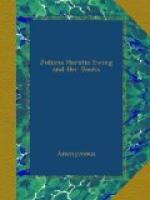I spoke of “Melchior’s Dream” and must revert to it again, for though it was written when my sister was only nineteen, I do not think she has surpassed it in any of her later domestic tales. Some of the writing in the introduction may be rougher and less finished than she was capable of in after-years, but the originality, power, and pathos of the Dream itself are beyond doubt. In it, too, she showed the talent which gives the highest value to all her work—that of teaching deep religious lessons without disgusting her readers by any approach to cant or goody-goodyism.
During the years 1862 to 1868, we kept up a MS. magazine, and, of course, Julie was our principal contributor. Many of her poems on local events were genuinely witty, and her serial tales the backbone of the periodical. The best of these was called “The Two Abbots: a Tale of Second Sight,” and in the course of it she introduced a hymn, which was afterwards set to music by Major Ewing and published in Boosey’s Royal Edition of “Sacred Songs,” under the title “From Fleeting Pleasures.”
The words of this hymn, and of two others which she wrote for the use of our Sunday school children at Whitsuntide in the respective years 1864 and 1866 have all been published in vol. ix. of the present Edition of her works.
Some years after she married, my sister again tried her hand at hymn-writing. On July 22, 1879, she wrote to her husband:
“I think I will finish my hymn of ‘Church of the Quick and Dead,’ and get thee to write a processional tune. The metre is (last verse)—
’Church of the Quick
and Dead,
Lift up, lift
up thy head,
Behold the Judge is standing
at the door!
Bride of the Lamb,
arise!
From whose woe-wearied
eyes
My God shall wipe all tears
for evermore.’”
My sister published very few of the things which she wrote to amuse us in our MS. “Gunpowder Plot Magazine,” for they chiefly referred to local and family events; but “The Blue Bells on the Lea” was an exception. The scene of this is a hill-side near our old home, and Mr. Andre’s fantastic and graceful illustrations to the verses when they came out as a book, gave her full satisfaction and delight.
In June 1865 she contributed a short parochial tale, “The Yew Lane Ghosts,” to the Monthly Packet, and during the same year she gave a somewhat sensational story, called “The Mystery of the Bloody Hand,"[8] to London Society. Julie found no real satisfaction in writing this kind of literature, and she soon discarded it; but her first attempt showed some promise of the prolific power of her imagination, for Mr. Shirley Brooks, who read the tale impartially, not knowing who had written it, wrote the following criticism: “If the author has leisure and inclination to make a picture instead of a sketch, the material, judiciously treated, would make a novel, and I especially see in the character and sufferings of the Quaker, previous to his crime, matter for effective psychological treatment. The contrast between the semi-insane nature and that of the hypocrite might be powerfully worked up; but these are mere suggestions from an old craftsman, who never expects younger ones to see things as veterans do.”




